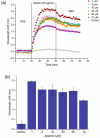Porous Silicon-Based Aptasensors: The Next Generation of Label-Free Devices for Health Monitoring
- PMID: 31200538
- PMCID: PMC6630495
- DOI: 10.3390/molecules24122216
Porous Silicon-Based Aptasensors: The Next Generation of Label-Free Devices for Health Monitoring
Abstract
Aptamers are artificial nucleic acid ligands identified and obtained from combinatorial libraries of synthetic nucleic acids through the in vitro process SELEX (systematic evolution of ligands by exponential enrichment). Aptamers are able to bind an ample range of non-nucleic acid targets with great specificity and affinity. Devices based on aptamers as bio-recognition elements open up a new generation of biosensors called aptasensors. This review focuses on some recent achievements in the design of advanced label-free optical aptasensors using porous silicon (PSi) as a transducer surface for the detection of pathogenic microorganisms and diagnostic molecules with high sensitivity, reliability and low limit of detection (LoD).
Keywords: aptamer; aptasensor; optical label free-sensing; porous silicon; surface modification.
Conflict of interest statement
The authors declare no conflict of interest.
Figures






References
-
- Dancil K.P.S., Greiner D.P., Sailor M.J. A porous silicon optical biosensor: Detection of reversible binding of IgG to a protein A-modified surface. J. Am. Chem. Soc. 1999;121:7925–7930. doi: 10.1021/ja991421n. - DOI
-
- De Stefano L., Rea I., Giardina P., Armenante A., Rendina I. Protein-Modified Porous Silicon Nanostructures. Adv. Mat. 2008;20:1529–1533. doi: 10.1002/adma.200702454. - DOI
-
- Lehninger A.L., Nelson D.L., Cox M.M. The Molecular Basis of Cell Structure and Function, Biochemistry. 2nd ed. Worth Publishers; New York, NY, USA: 1975. pp. 71–77.
Publication types
MeSH terms
Substances
LinkOut - more resources
Full Text Sources

